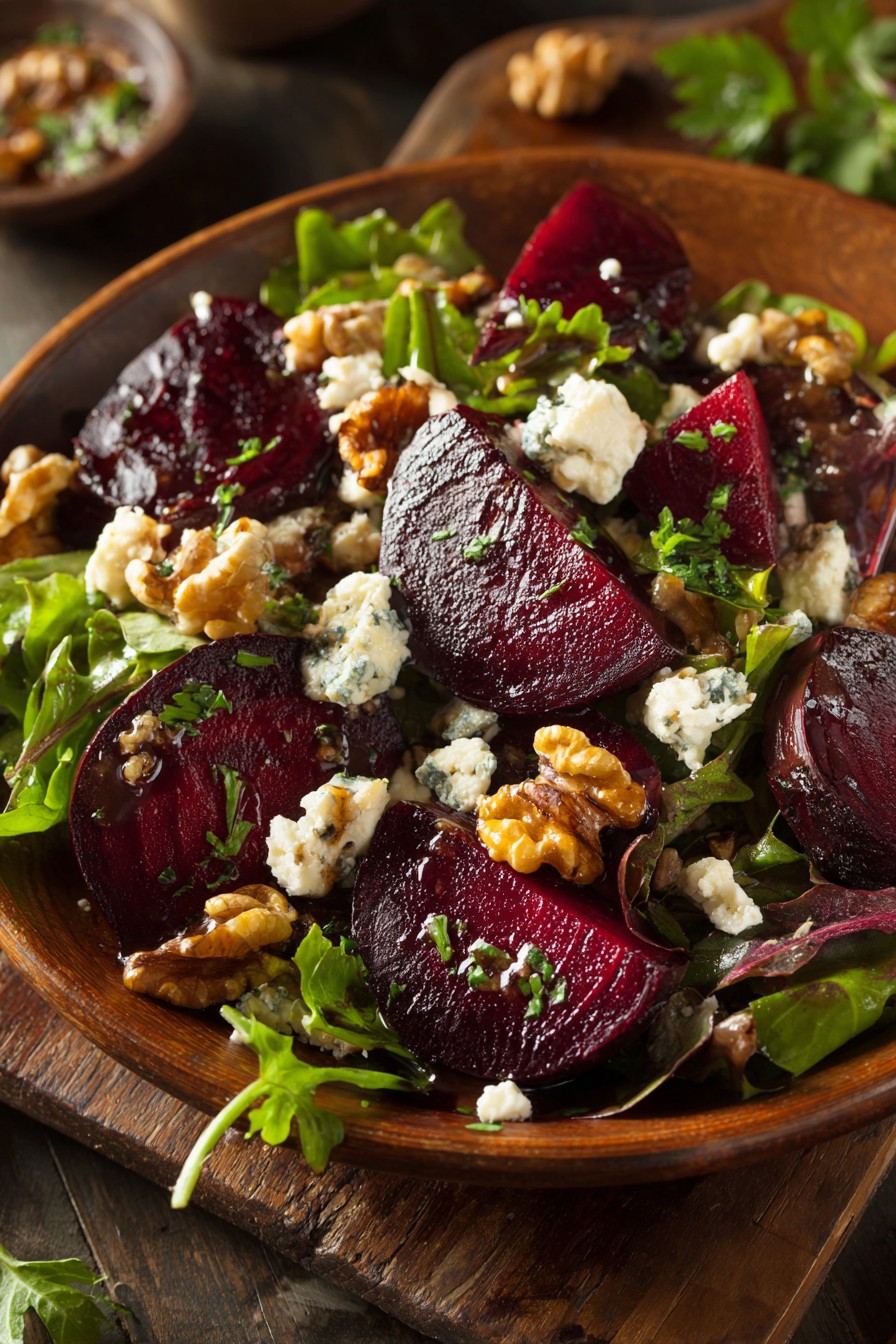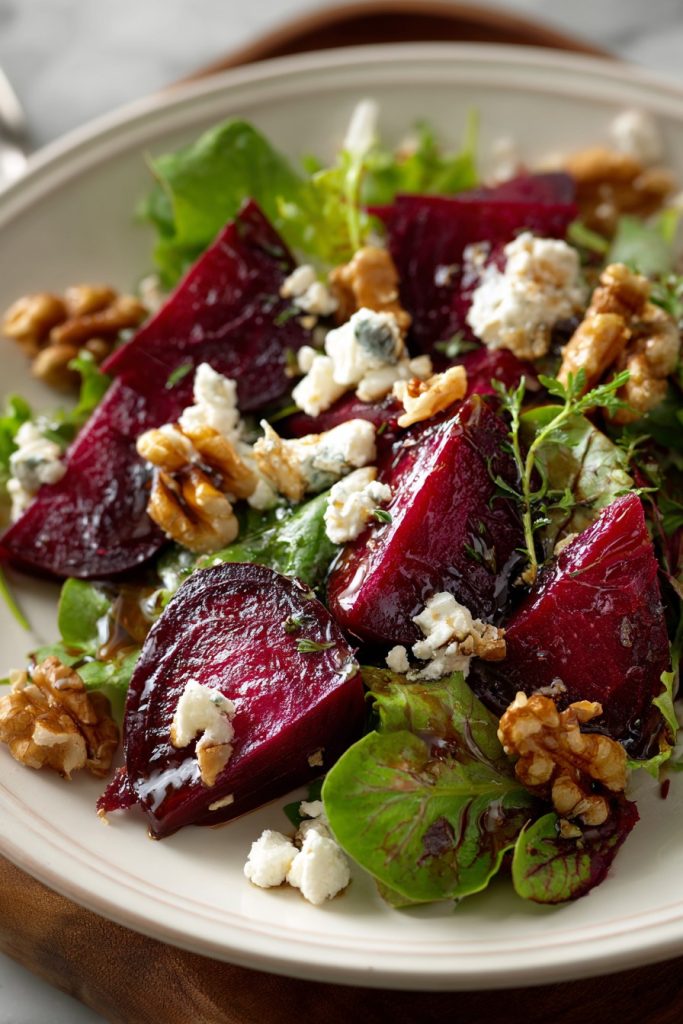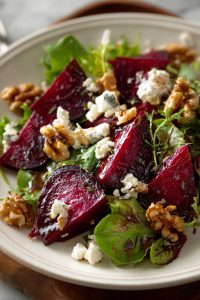A cherished memory from my childhood summers spent at my grandmother’s farmhouse always involved the earthy sweetness of freshly harvested beets. Around her worn wooden table, we’d gather as she prepared this very salad, the vibrant crimson juices staining her apron while she shared stories of simpler times. This humble dish captures the essence of those golden afternoons, where good food and family stories blended together like the perfect dressing.
Why This Recipe Works
This recipe stands the test of time because it honors the natural sweetness of beets through slow roasting, which caramelizes their sugars and deepens their earthy flavor in ways boiling simply cannot achieve. The combination of creamy goat cheese provides a tangy contrast that cuts through the richness, while toasted walnuts add satisfying crunch and nutty depth that complements the tender beets beautifully. Our simple maple-balsamic dressing strikes the perfect balance between sweet and acidic, clinging to every ingredient without overwhelming their natural flavors. Finally, the addition of fresh herbs like thyme and parsley brings a bright, aromatic quality that elevates this from a simple side dish to something truly special worthy of any family gathering.
Ingredients
– 2 pounds fresh beets, scrubbed clean and trimmed
– 3 tablespoons extra virgin olive oil, divided
– 1 teaspoon sea salt
– 1/2 teaspoon freshly ground black pepper
– 4 cups mixed baby greens
– 1/2 cup crumbled goat cheese
– 1/2 cup toasted walnut pieces
– 1/4 cup fresh parsley, roughly chopped
– 2 teaspoons fresh thyme leaves
– 2 tablespoons pure maple syrup
– 3 tablespoons balsamic vinegar
– 1 small shallot, finely minced
– 1 teaspoon Dijon mustard
Equipment Needed
– Rimmed baking sheet
– Parchment paper
– Medium mixing bowl
– Small whisk
– Measuring cups and spoons
– Sharp chef’s knife
– Cutting board
– Small skillet for toasting walnuts
Instructions

Preparing and Roasting the Beets
Begin by preheating your oven to 400°F and lining a rimmed baking sheet with parchment paper to make cleanup easier. Take your scrubbed beets and pat them completely dry with a clean kitchen towel, then place them in a medium mixing bowl. Drizzle the beets with one tablespoon of olive oil, using your hands to rub the oil evenly over each beet’s surface until they glisten. Sprinkle generously with sea salt and freshly ground black pepper, making sure every beet gets seasoned. Arrange the beets in a single layer on your prepared baking sheet, leaving a little space between each one for even heat circulation. Roast for 45 to 60 minutes, depending on their size, until you can easily pierce the largest beet with a fork and it meets no resistance. The skins will become slightly wrinkled and darkened in spots, telling you they’re perfectly caramelized inside. A little trick my grandmother taught me: if you’re unsure whether they’re done, remove one beet and carefully slice it in half – the interior should be uniformly tender and deeply colored throughout.
Creating the Maple-Balsamic Dressing
While the beets are roasting, prepare your dressing in that same medium mixing bowl you used earlier – no need to wash it, as those residual beet juices will add extra flavor. Start by combining the finely minced shallot with the Dijon mustard, using your whisk to blend them together until they form a smooth paste. Slowly drizzle in the remaining two tablespoons of olive oil while continuously whisking, creating an emulsion that will keep your dressing from separating. Add the balsamic vinegar and maple syrup, whisking vigorously until the dressing becomes slightly thickened and perfectly blended. Taste and adjust seasoning if needed – you might want an extra pinch of salt or another drizzle of maple syrup depending on your preference. Let this dressing sit at room temperature while the beets finish roasting, allowing the shallot to mellow and the flavors to marry together beautifully.
Toasting the Walnuts and Preparing Greens
Place your walnut pieces in a dry skillet over medium-low heat, shaking the pan frequently to prevent burning. Toast for 3 to 5 minutes until they become fragrant and develop a slightly deeper color, watching carefully as nuts can go from perfectly toasted to burnt in moments. Immediately transfer them to a cool plate to stop the cooking process. Now take your mixed baby greens and give them a good rinse in cold water, then spin them dry in a salad spinner or pat gently with paper towels until no moisture remains. Place the dried greens in your serving bowl and scatter the fresh parsley and thyme leaves over the top. The key here is having completely dry greens so your dressing will cling properly rather than sliding off.
Assembling the Salad Components
Once your beets are out of the oven and cool enough to handle, use a paper towel to gently rub away the skins – they should slip off easily, revealing the gorgeous jewel-toned flesh beneath. Slice the peeled beets into wedges or half-moons about 1/4-inch thick, being careful as the vibrant juice can stain cutting boards and hands. Arrange the warm beet slices over your bed of greens, then sprinkle generously with the crumbled goat cheese and toasted walnuts. The warmth from the beets will slightly melt the goat cheese, creating lovely creamy pockets throughout the salad. Another grandmotherly tip: if you want to prevent your hands from staining beet-red, you can wear disposable gloves while handling the warm beets, though I’ve always thought those colorful fingers were part of the cooking experience.
Final Dressing and Serving
Give your prepared dressing one final vigorous whisk to recombine any ingredients that may have settled, then drizzle about two-thirds of it over the assembled salad. Using salad tongs or two large spoons, gently toss everything together, being careful not to break up the beet slices too much. Taste a bite and decide if you’d like to add the remaining dressing – I usually find the initial amount perfect, but preferences vary. Serve immediately while the beets are still slightly warm, as this temperature contrast with the cool greens makes for a wonderfully satisfying eating experience. The final touch my grandmother always added was an extra sprinkle of flaky sea salt over the top just before serving to make all the flavors pop.
Tips and Tricks
If you want to save time on busy days, you can roast the beets up to three days in advance and store them peeled and sliced in an airtight container in the refrigerator. Simply bring them to room temperature or gently warm them before assembling your salad. When selecting beets at the market, look for ones that feel firm and heavy for their size with smooth, unblemished skins and vibrant green tops still attached if possible – these indicate freshness. If you end up with beets that still have their greens, don’t toss them! Those beet greens can be sautéed with garlic and olive oil just like spinach or chard, making for a wonderful side dish that reduces waste. For the creamiest goat cheese experience, take it out of the refrigerator about thirty minutes before you plan to assemble the salad – cold goat cheese tends to crumble less evenly. When toasting walnuts, keep a close eye on them and use your nose as your guide; the moment you smell that rich, nutty aroma, they’re ready to come off the heat. If you’re serving this salad for a special occasion, consider using a mix of golden and red beets for stunning visual appeal, but keep them separate during roasting and dressing to prevent the red beets from staining the golden ones. For the most flavorful dressing, use the best quality extra virgin olive oil and aged balsamic vinegar you can afford – these simple ingredients really make a difference in the final result. If you find your dressing too tart, add another teaspoon of maple syrup; if it’s too sweet, balance it with an extra splash of balsamic vinegar. When handling beets, an old farmhouse trick is to rub your hands with lemon juice afterward to help remove any stubborn stains from your skin.
Recipe Variations
For a heartier main-course salad, add grilled chicken or flaked roasted salmon over the top, making sure to season the protein simply with salt and pepper so it doesn’t compete with the beets’ natural sweetness. If you’re not a fan of goat cheese, try substituting with creamy feta or tangy blue cheese crumbles, or for a dairy-free version, use toasted pepitas or sunflower seeds for that contrasting texture. During summer months when fresh berries are abundant, toss in a handful of raspberries or sliced strawberries – their bright acidity plays wonderfully against the earthy beets. For an autumn-inspired twist, replace the walnuts with toasted pecans and add roasted cubed butternut squash or sweet potatoes to the mix, using apple cider vinegar in place of balsamic in the dressing. If you prefer different herbs, fresh dill or basil make excellent substitutes for the thyme and parsley, each bringing their own unique character to the dish. For a more substantial grain salad, fold in cooked farro or quinoa after dressing, allowing the grains to soak up that lovely maple-balsamic flavor while adding wonderful chewiness.
Frequently Asked Questions
Can I use canned beets instead of fresh?
While canned beets will work in a pinch, I highly recommend taking the extra time to roast fresh beets if possible. The roasting process caramelizes the natural sugars in fresh beets, creating a depth of flavor and tender texture that canned versions simply can’t match. Canned beets tend to be softer and sometimes have a metallic undertone from the canning process, whereas roasted fresh beets maintain a wonderful firm-yet-tender bite and pure, earthy sweetness. If you must use canned beets, be sure to drain and rinse them thoroughly to remove the canned liquid, then pat them completely dry before using. You might also want to reduce the maple syrup in the dressing slightly since canned beets are often packed in sweetened liquid.
How long will this salad keep in the refrigerator?
The assembled salad is best enjoyed immediately after preparation, as the greens will wilt and the walnuts will lose their crunch over time. However, you can prepare components ahead of time and store them separately for up to three days. Keep the roasted beets in an airtight container, the dressing in a jar with a tight lid, and the toasted walnuts at room temperature in a sealed bag. The greens should be washed and dried, then stored in the refrigerator with a paper towel to absorb excess moisture. When ready to serve, simply assemble everything fresh. If you have leftover assembled salad, it will keep for about a day, though the texture will be softer.
What’s the best way to prevent beet stains on hands and cutting boards?
The vibrant pigments in beets can indeed leave stubborn stains, but there are several effective methods to manage this. Wearing disposable food-safe gloves while handling warm roasted beets is the most straightforward approach. If you prefer not to use gloves, immediately after working with beets, rub your hands with lemon juice or vinegar followed by salt, then wash with soap and water – the acid helps break down the pigments. For cutting boards, sprinkle with coarse salt and rub with half a lemon before washing. Some old-timers swear by rubbing hands with a raw potato slice afterward, though I’ve found the lemon method more reliable. Embrace the stains as part of the process – they usually fade within a day or two.
Can I make this recipe vegan?
Absolutely! This salad adapts beautifully to a vegan diet with just a couple of simple substitutions. Instead of goat cheese, use crumbled firm tofu that’s been marinated in lemon juice and nutritional yeast, or try a commercial vegan feta alternative. For the maple-balsamic dressing, it’s already naturally vegan as long as you confirm your maple syrup and Dijon mustard don’t contain any animal-derived ingredients (most don’t). The toasted walnuts provide plenty of richness and protein, but you could also add roasted chickpeas for extra substance. The result will be just as satisfying and flavorful while aligning with vegan dietary preferences.
What other nuts work well in this salad?
While walnuts are traditional and provide wonderful flavor pairing with the beets, many other nuts make excellent alternatives depending on your preference and what you have available. Pecans offer a slightly sweeter, buttery flavor that complements the maple dressing beautifully. Toasted almonds provide a lighter, crunchier texture and more subtle nuttiness. Hazelnuts bring an elegant, sophisticated flavor when toasted and skinned. For those with nut allergies, sunflower seeds or pepitas make excellent substitutes while still providing that essential crunchy element. Whatever nut or seed you choose, toasting them first is crucial for developing their full flavor potential.
Summary
This rustic beet salad celebrates simple ingredients transformed through careful preparation. Roasted beets, tangy goat cheese, and toasted walnuts come together in a harmony of textures and flavors, dressed in a sweet-tart maple-balsamic vinaigrette that ties everything together beautifully. Perfect for family gatherings or quiet weeknight meals, this recipe carries the warmth of generations in every bite.



